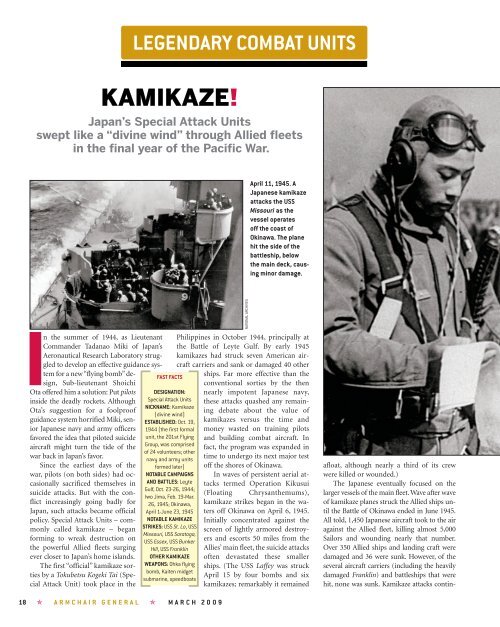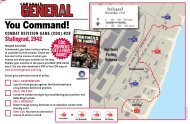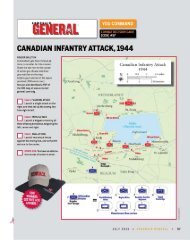CONTENTSFebruary / March 09VOLUME VI ISSUE 1COVER STORY42 World War II’s Bomber BaronsThe strategic bombing campaigns of three key Allied leaders,Harris, Spaatz and LeMay, turned German cities to rubbleand reduced Japan to ashes. By Jeffrey C. PraterFEATURESYOU ARE THERE28 MacArthur at Buna, 1942Eavesdrop on <strong>General</strong> Douglas MacArthur during one ofmilitary history’s great moments.TEN QUESTIONS30 <strong>General</strong> Raymond T. OdiernoAn exclusive interview with the commander of Coalitionforces on the front line in the War on Terrorism in Iraq.By Lieutenant Colonel Bradley T. Gericke, PhD, andCaptain Seth BodnarHISTORY IN DEPTH34 Hiroshima ReconsideredConflicting American demands – for the enemy’s “unconditionalsurrender” and for the demobilization of the meansto achieve it – made the atomic bombing of Japan inevitable.By Michael D. PearlmanINTERACTIVECOMBAT!51 Winter War, 1939Choose the correct course of action as Finnish troops facethe invading “Russian bear.”YOU COMMAND54 German Glider Assault on Crete, 1941Test your combat decision-making skills as the commander ofa German glider battalion attacking the British-heldisland of Crete.YOU COMMAND SOLUTION60 Aussies at Buna, 1942Historical outcome and winning Reader Solutions toCDG #29, November 2008 issue.WHAT NEXT, GENERAL?64 Arthur “Bomber” Harris, 1942<strong>Armchair</strong> <strong>General</strong> challenges YOU to devise a winningstrategy for the Royal Air Force’s bombing campaign againstNazi Germany! By Richard N. Armstrong<strong>Armchair</strong> <strong>General</strong>® (ISSN 1546-055X) is published bimonthly by <strong>Armchair</strong> <strong>General</strong>®, LLC, 4165 E. Thousand Oaks Blvd., Suite255, Thousand Oaks, CA 91362. Periodicals Postage paid at the Thousand Oaks Post Office and at additional mailing offices. Subscriptionrate is $29.95 for 6 issues (one year). Subscriptions sent outside of U.S. must be prepaid in U.S. funds with an additional$12 for surface postage and $20 for airmail postage. For Customer Service e-mail us at subscriptions@armchairgeneral.comor call us at (800)755-1366 or (386)246-3456. Canadian Post International Sales Agreement #40852014. POSTMASTER: Sendaddress changes to <strong>Armchair</strong> <strong>General</strong>®, P.O. Box 420235, Palm Coast, FL 32164-0235. Copyright ©2008. <strong>Armchair</strong> <strong>General</strong>®, LLC.All rights reserved. No part of this publication may be reproduced or transmitted in any form or by any means, electronic,mechanical, including photocopy, recording, or any information storage and retrieval system, without written permission.The views expressed herein are those of the authors and are not necessarily those of <strong>Armchair</strong> <strong>General</strong>®, LLC.4 PUBLISHER’S NOTE5 EDITOR’S LETTER6 MAILBAG8 CRISIS WATCHLearning From GeorgiaIt’s time to rethink futureweaponry. By Ralph Peters10 DISPATCHESReal heroes, collector’s corner,significant events in historyand much more!16 FORGOTTEN HISTORYImperial Dreams: JapanInvades Korea, 1592-98Japan’s first spasm of expansionistaggression has largelybeen forgotten.18 LEGENDARY COMBAT UNITSKamikaze!Japan’s Special Attack Unitsswept like a “divine wind”through Allied fleets in thePacific War.20 GREAT WARRIORSGerman World War IStorm TroopersThe Kaiser’s elite assault troopspioneered innovative tacticsthat evolved into WorldWar II’s blitzkrieg.22 BADGES OF HONORLegion of MeritCreated during World War II,this U.S. medal recognizesexceptionally meritoriousconduct.DEPARTMENTS24 HARD CHOICESMacArthur’s BloodlessVictoryU.S. troops confronted angryAmerican war vets in thestreets of Washington, D.C.,in 1932.26 SPY WARSThe Culper RingGeorge Washington’s spieswere the unsung heroes of theRevolutionary War.80 LEADERCurtis E. LeMay,Air Force LegendREVIEWS73 GAME BUZZThe scoop on some of today’slatest titles!74 VIDEO GAME REVIEWMercenaries 2:World in Flames75 WARGAME REVIEWGary Grigsby’s War Betweenthe States and Birth ofAmerica 2: Wars in America76 BOOKSHELFWarlordCarlo D’Este’s new must-readbiography of Winston Churchill.78 DVD LIBRARYBomber War on FilmA dozen films depicting WorldWar II’s bomber campaigns.ON THE COVER1944. Boeing B-29Superfortressesconduct a bombingmission over theMariana Islandsduring World War II.COVER: LOOMIS DEAN/U.S. ARMY AIR SERVICES-PACIFIC ARENA AREAS/TIME & LIFE PICTURES/GETTY IMAGES2 ✯ ARMCHAIR GENERAL ✯ MARCH 2009
LEGENDARY COMBAT UNITSKAMIKAZE!Japan’s Special Attack Unitsswept like a “divine wind” through Allied fleetsin the final year of the Pacific War.April 11, 1945. AJapanese kamikazeattacks the USSMissouri as thevessel operatesoff the coast ofOkinawa. The planehit the side of thebattleship, belowthe main deck, causingminor damage.In the summer of 1944, as LieutenantCommander Tadanao Miki of Japan’sAeronautical Research Laboratory struggledto develop an effective guidance systemfor a new “flying bomb” design,Sub-lieutenant ShoichiFAST FACTSOta offered him a solution: Put pilotsinside the deadly rockets. AlthoughOta’s suggestion for a foolproofguidance system horrified Miki, seniorJapanese navy and army officersfavored the idea that piloted suicideaircraft might turn the tide of thewar back in Japan’s favor.Since the earliest days of thewar, pilots (on both sides) had occasionallysacrificed themselves insuicide attacks. But with the conflictincreasingly going badly forJapan, such attacks became officialpolicy. Special Attack Units – commonlycalled kamikaze – beganforming to wreak destruction onthe powerful Allied fleets surgingever closer to Japan’s home islands.The first “official” kamikaze sortiesby a Tokubetsu Kogeki Tai (SpecialAttack Unit) took place in theDESIGNATION:Special Attack UnitsNICKNAME: Kamikaze(divine wind)ESTABLISHED: Oct. 19,1944 (the first formalunit, the 201st FlyingGroup, was comprisedof 24 volunteers; othernavy and army unitsformed later)NOTABLE CAMPAIGNSAND BATTLES: LeyteGulf, Oct. 23-26, 1944;Iwo Jima, Feb. 19-Mar.26, 1945; Okinawa,April 1-June 23, 1945NOTABLE KAMIKAZESTRIKES: USS St. Lo, USSMissouri, USS Saratoga,USS Essex, USS BunkerHill, USS FranklinOTHER KAMIKAZEWEAPONS: Ohka flyingbomb, Kaiten midgetsubmarine, speedboatsPhilippines in October 1944, principally atthe Battle of Leyte Gulf. By early 1945kamikazes had struck seven American aircraftcarriers and sank or damaged 40 otherNATIONAL ARCHIVESships. Far more effective than theconventional sorties by the thennearly impotent Japanese navy,these attacks quashed any remainingdebate about the value ofkamikazes versus the time andmoney wasted on training pilotsand building combat aircraft. Infact, the program was expanded intime to undergo its next major testoff the shores of Okinawa.In waves of persistent aerial attackstermed Operation Kikusui(Floating Chrysanthemums),kamikaze strikes began in the watersoff Okinawa on April 6, 1945.Initially concentrated against thescreen of lightly armored destroyersand escorts 50 miles from theAllies’ main fleet, the suicide attacksoften devastated these smallerships. (The USS Laffey was struckApril 15 by four bombs and sixkamikazes; remarkably it remainedafloat, although nearly a third of its crewwere killed or wounded.)The Japanese eventually focused on thelarger vessels of the main fleet. Wave after waveof kamikaze planes struck the Allied ships untilthe Battle of Okinawa ended in June 1945.All told, 1,450 Japanese aircraft took to the airagainst the Allied fleet, killing almost 5,000Sailors and wounding nearly that number.Over 350 Allied ships and landing craft weredamaged and 36 were sunk. However, of theseveral aircraft carriers (including the heavilydamaged Franklin) and battleships that werehit, none was sunk. Kamikaze attacks contin-18 ✯ ARMCHAIR GENERAL ✯ MARCH 2009








